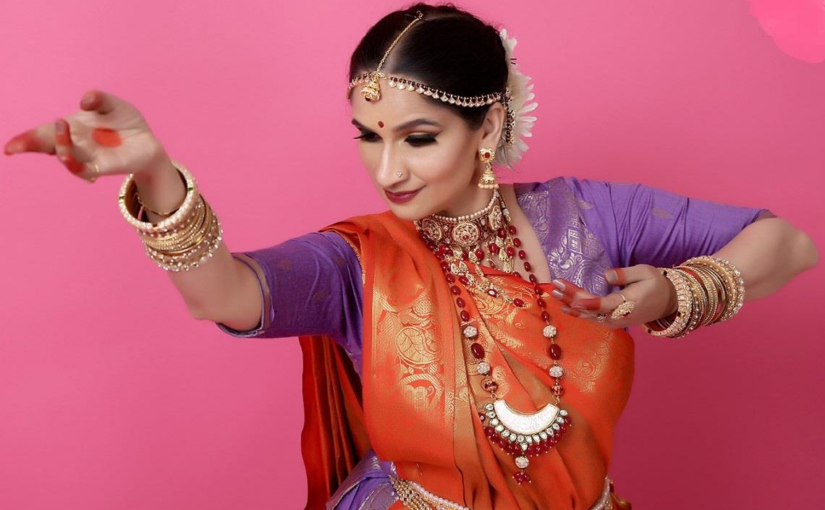21 TO 25 octobeR 2024
IN AIX-EN-PROVENCE CONSERVATORY
OBJECTIVE
The aim is to introduce you to the art of classical North Indian Kathak dance. The form of workshop I propose is based on all my professional experience. Teaching the history and theories of dance, singing Bôles (rhythmic onomatopoeia) to vocalise the subdivision and phrasing of beats, using hand clapping as a technique for finding your bearings in the cycles. In this workshop, which is aimed at dancers from all dance backgrounds, we will delve into choreography based on the fluidity of dance and Indian rhythm.
REPERTOIRE & HISTORY
Teaching the Kathak dance “Lukhnow Gharana” (from the Lukhnow school) / Musical culture & body percussion / The subtleties of interpretation according to the major schools / The art of improvisation / Learning grammatical rigour.
Kathak, the classical dance of North India, is a 3000-year-old art form. The word “kathak” derives from the word “katha” or “telling a story”. Katha kahe so kathak: anyone who tells a story while dancing is a kathak. Originally, this community of artists known as Kathakar told mythological stories in the Hindu temples of northern India. Their art is undoubtedly rooted in Hindu religious and devotional practice. The hand (mudra) and body movements, as well as the facial expressions (abhinaya) used by Kathakars to enrich their narration, give rise to Kathak. The knowledge of the Kathakars has been passed down from generation to generation in the oral tradition.
Under the reign of the Mughal dynasties, between the 11th and 18th centuries, Kathak left the confines of temples and entered the sumptuous palaces of Muslim emperors and Hindu kings. From a purely devotional practice, it evolved into a court dance intended for the pleasure of these high and mighty lords. It adopted typically Persian cultural elements and flourished.
Under the patronage of the Mughals, Kathak took on the form we know today. Initially essentially Hindu, the aesthetic of this dance evolved in line with the aesthetic of Muslim culture. As a result, expression, mime and movement became more subtle, with the artist endeavouring to express the same theme in a thousand and one ways, thanks to minute nuances. The pure dance or nritta aspect of Kathak is also becoming highly sophisticated, with more complex rhythms, movements and pirouettes. Kathak also became imbued with Urdu poetry.
Today, Kathak is the only classical dance in India that combines Hindu and Muslim cultures.
CONTENT
DAY 1
- Introduction to Kathak music and dance Spirituality, Gestures, Rhythm,
- Emotions, Feelings, History.
- Working with the 16-beat rhythm (TEENTAL)
- Warming up with the Kathak dance greeting (Namaskar)
- Basic exercises the HASTAKS (arm movements)
- Working on rhythm, regularity, intensity, tempo,
- Working in space, moving around, walking,
- Footwork (Tatkar)
- Pirouettes (Chakaar): 1,2 ,3, 4, 5 and 8 beats which are all the possibilities of pirouettes in Kathak.
DAY 2
- Nritta: technical and rhythmic dance.
- Learning mudras, the language of one-handed (ASAMYUKTA HASTA) and two-handed (SAMYUKTA HASTA) hands.
- Working on rhythm, regularity, intensity, tempo,
- Working with space, movement, walking, jumping, turning
DAY 3
- Basic TATKAR footwork (foot strikes) in Vilanbit laya , Madhya Lay and Drut lay (slow, intermediate and fast 3 different speeds)
- Technical choreography: combining feet and arms to dance and tabla syllables
- Singing of rhythmic claps (Padhant)
- Introduction of different rhythms used in Kathak TUKRAS ,TIHAIS LADI
DAY 4
- Work on the face (abhinaya)
- Work on Navras: Nine Feelings (facial expression)
- Work on two different choreographies
- TAAL VISTAR pure dance technique
- an expressive choreography
DAY 5
- improvisation on TEEN TAAL
- Work on other rhythms Japtaal (10 TIMES) and Dhamar taal (14 TIMES)
- Continued work on choreography
TIMETABLE : 10h00 – 13h00 // 14h00 – 16h00
CONDITIONS TO PARTICIPATE
- Adolescents and adults, women and men, all levels, no previous knowledge required.
- This course will suit everyone’s abilities, whether you’re a beginner or have some experience of dance or even Kathak dance.
REGISTER NOW
>> ON-LINE REGISTRATION <<
>> RATES & REGISTRATION PROCESS <<
BIOGRAPHY
Sharmila Sharma is passionate about reviving the age-old heritage of Indian classical dance. She began learning her art at a very early age from her mother Tara Sharma, Pandit Rajendra Kumar Gangani and the legendary Pandit Birju Maharaj. Sharmila became a professional dancer at the age of fourteen. She has toured extensively with her company and performed at numerous national and international festivals in 35 countries. She has created numerous works and collaborated with flamenco groups, Iranian musicians and Renaissance music. She was the first dancer to introduce Kathak to France.
Translated with DeepL.com (free version)
A passionate teacher, she devotes herself to passing on the heritage of a long classical tradition handed down by her masters, which she enriches with her international experience, forged through numerous artistic and multicultural dialogues.
Since 1993, her artistic activity has been complemented by an intense teaching and masterclass activity at various conservatoires in France and in associations around the world.
Translated with DeepL.com (free version)
